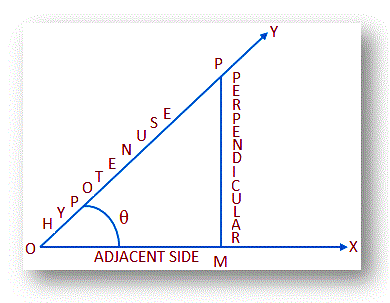Subscribe to our ▶️ YouTube channel 🔴 for the latest videos, updates, and tips.
Limit of Trigonometric Ratios
In limit of trigonometric ratios we will learn how to find the limits to the values of sin θ, csc θ, cos θ, sec θ, tan θ and cot θ.
According to the definitions of the trigonometrical ratios of a positive acute angle are always positive.
Note:
Remember that the trigonometrical ratios may be positive as well as negative.
We get from the definitions of trigonometrical ratios that,
Sin θ = PM/OP and Cos θ = OM/OP …….. (A)
From the above picture, OP is the hypotenuse of the triangle POM; hence, PM ≮ OP and OM ≮ OP.
Therefore, from (A) we get the values of sin θ and cos θ cannot be greater than 1.
Again, csc θ = OP/PM and sec θ = OP/OM
Therefore, it is clearly seen that the values of csc θ and sec θ can never be less than 1.
Finally, tan θ = PM/OM and cot θ = OM/PM
In this case, the values of PM may be greater or less or equal to the values of OM. Thus, the values of tan θ or cot θ may have any non-negative value.
Therefore, the limit of trigonometric ratios of a positive acute angle θ is always non-negative:
(i) The values of sin θ and cos θ cannot be greater than 1;
(ii) The values of csc θ and sec θ cannot be less than 1; and
(iii) The values of tan θ and cot θ can have any value.
● Trigonometric Functions
- Basic Trigonometric Ratios and Their Names
- Restrictions of Trigonometrical Ratios
- Reciprocal Relations of Trigonometric Ratios
- Quotient Relations of Trigonometric Ratios
- Limit of Trigonometric Ratios
- Trigonometrical Identity
- Problems on Trigonometric Identities
- Elimination of Trigonometric Ratios
- Eliminate Theta between the equations
- Problems on Eliminate Theta
- Trig Ratio Problems
- Proving Trigonometric Ratios
- Trig Ratios Proving Problems
- Verify Trigonometric Identities
- Trigonometrical Ratios of 0°
- Trigonometrical Ratios of 30°
- Trigonometrical Ratios of 45°
- Trigonometrical Ratios of 60°
- Trigonometrical Ratios of 90°
- Trigonometrical Ratios Table
- Problems on Trigonometric Ratio of Standard Angle
- Trigonometrical Ratios of Complementary Angles
- Rules of Trigonometric Signs
- Signs of Trigonometrical Ratios
- All Sin Tan Cos Rule
- Trigonometrical Ratios of (- θ)
- Trigonometrical Ratios of (90° + θ)
- Trigonometrical Ratios of (90° - θ)
- Trigonometrical Ratios of (180° + θ)
- Trigonometrical Ratios of (180° - θ)
- Trigonometrical Ratios of (270° + θ)
- Trigonometrical Ratios of (270° - θ)
- Trigonometrical Ratios of (360° + θ)
- Trigonometrical Ratios of (360° - θ)
- Trigonometrical Ratios of any Angle
- Trigonometrical Ratios of some Particular Angles
- Trigonometric Ratios of an Angle
- Trigonometric Functions of any Angles
- Problems on Trigonometric Ratios of an Angle
- Problems on Signs of Trigonometrical Ratios
From Limit of Trigonometric Ratios to HOME PAGE
Didn't find what you were looking for? Or want to know more information about Math Only Math. Use this Google Search to find what you need.



New! Comments
Have your say about what you just read! Leave me a comment in the box below. Ask a Question or Answer a Question.